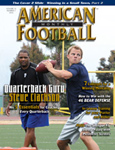Article CategoriesAFM Magazine
|
The 46 Bear Defenseby: Kai SmalleyHead Coach, Park City High School (UT) © More from this issue The 46 Bear defense, or Kodiak, is intended to prove one thing – pressure wins ball games. Stop the run, force bad throws and take the offense out of their comfort zone. The Bear does this in a lot of different aspects. In fact, the defense itself is not named like the 4-3 or 3-4, but rather after the player’s number that Buddy Ryan thought best exemplified the attacking style of this defense – Chicago Bears defensive back Doug Plank, who wore number 46. He played strong safety in this defense, which actually places another linebacker on the field. The advantages we have found with this defense are numerous. First of all, the center and both guards are covered up, which makes traps, double teams and zone blocks very difficult. Second, we have an extra inside linebacker with the athletic ability of a safety. Third, the ....The full article can only be seen by subscribers.
|
|
|||||||
| HOME |
MAGAZINE |
SUBSCRIBE | ONLINE COLUMNISTS | COACHING VIDEOS |
Copyright 2025, AmericanFootballMonthly.com
All Rights Reserved





